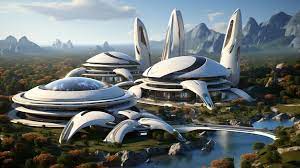Exploring the Boundaries of Futuristic Building Design: A Glimpse into Tomorrow’s Architecture

The Future of Building Design: Embracing Futuristic Architecture
In recent years, the world of architecture has seen a shift towards futuristic building design that challenges traditional norms and pushes the boundaries of innovation. From sleek, energy-efficient skyscrapers to sustainable eco-friendly structures, architects are embracing new technologies and materials to create buildings that not only look impressive but also function in ways never imagined before.
One of the key elements of futuristic building design is the integration of smart technology. Buildings are now being designed with advanced automation systems that control everything from lighting and temperature to security and energy usage. This not only enhances the comfort and convenience of occupants but also reduces energy consumption and environmental impact.
Another trend in futuristic building design is the use of sustainable materials and green building practices. Architects are increasingly incorporating features such as green roofs, solar panels, and natural ventilation systems to reduce carbon footprint and promote eco-friendliness. These buildings not only benefit the environment but also provide healthier living spaces for occupants.
Furthermore, futuristic architecture often focuses on unique shapes, forms, and facades that challenge traditional aesthetics. Buildings with dynamic curves, unconventional geometries, and innovative facades create visually striking landmarks that stand out in city skylines.
As we look towards the future, it’s clear that futuristic building design will continue to evolve and shape our urban landscapes in exciting ways. By embracing new technologies, sustainable practices, and innovative approaches to design, architects are creating buildings that are not only functional but also visionary works of art.
“Smart Technology Integration in Futuristic Building Design”
“Sustainable Practices in the Realm of Futuristic Building Architecture”
4. “The Art of Unique Shapes and
- What are the key features of futuristic building design?
- How does smart technology play a role in futuristic building design?
- What sustainable practices are commonly used in futuristic building design?
- How do architects incorporate unique shapes and forms into futuristic buildings?
- What impact does futuristic building design have on energy efficiency and environmental sustainability?
What are the key features of futuristic building design?
Futuristic building design encompasses several key features that set it apart from traditional architecture. These features include the integration of smart technology for automation and energy efficiency, the use of sustainable materials and green building practices to promote environmental consciousness, and the incorporation of unique shapes, forms, and facades that challenge conventional aesthetics. By embracing these elements, futuristic building design aims to create structures that are not only visually striking but also functional, eco-friendly, and technologically advanced, shaping the future of architecture in innovative ways.
How does smart technology play a role in futuristic building design?
Smart technology plays a crucial role in futuristic building design by revolutionizing the way buildings operate and interact with their occupants. Through the integration of advanced automation systems, sensors, and connectivity, smart buildings can optimize energy efficiency, enhance security measures, and improve overall comfort levels for residents. From controlling lighting and climate settings based on occupancy patterns to monitoring and adjusting energy usage in real-time, smart technology allows buildings to adapt to the needs of occupants seamlessly. This not only creates a more sustainable and efficient living or working environment but also sets the stage for a more interconnected and responsive future in architecture.
What sustainable practices are commonly used in futuristic building design?
In futuristic building design, several sustainable practices are commonly employed to reduce environmental impact and promote eco-friendly construction. These practices often include the use of renewable energy sources such as solar panels and wind turbines to generate electricity, green roofs and vertical gardens to enhance insulation and reduce heat absorption, rainwater harvesting systems for water conservation, energy-efficient lighting and HVAC systems for reduced energy consumption, and the integration of recycled or locally sourced materials to minimize waste production. By incorporating these sustainable practices into building design, architects are not only creating structures that are environmentally responsible but also contributing to a more sustainable future for generations to come.
How do architects incorporate unique shapes and forms into futuristic buildings?
Architects incorporate unique shapes and forms into futuristic buildings through innovative design techniques and advanced technologies. By utilizing computer-aided design (CAD) software, architects can experiment with complex geometries and unconventional structures that were once difficult to achieve. They also draw inspiration from nature, art, and technology to create buildings with dynamic curves, asymmetrical shapes, and futuristic facades. Additionally, the use of cutting-edge materials such as glass, steel, and carbon fiber allows architects to push the boundaries of traditional construction methods and bring their visionary designs to life in ways that were previously unimaginable.
What impact does futuristic building design have on energy efficiency and environmental sustainability?
Futuristic building design plays a crucial role in enhancing energy efficiency and promoting environmental sustainability. By incorporating advanced technologies such as smart systems, solar panels, and energy-efficient materials, futuristic buildings are able to reduce energy consumption and lower carbon emissions. These sustainable practices not only help in conserving resources but also contribute to creating healthier indoor environments for occupants. Additionally, the innovative design approaches in futuristic buildings, such as natural ventilation systems and green roofs, further enhance their eco-friendly footprint by minimizing waste and maximizing energy efficiency. Overall, futuristic building design sets a new standard for environmentally conscious construction practices that prioritize both energy efficiency and environmental sustainability.
